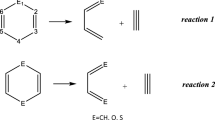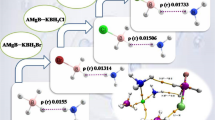Abstract
Exploring the different mechanisms involved in the application of actinide is necessary to obtain a more comprehensive understanding of actinide science. In this study, the mechanisms of gas-phase Np and Pu atoms dissociating NH3 molecules forming Neptunimine and Plutonimine complexes were systematically investigated using different approaches of density functional theory. A new dehydrogenation channel was discovered. The results reveal that the intermediates HAn-NH2 are the lowest energy in the overall reaction, and the direct planar evolution dehydrogenations are the lowest energy reaction path. Besides, the mechanism of the initial complexation process is discussed on the electron localization function, atoms-in-molecules, atomic dipole moment corrected Hirshfeld atomic charges, and electron density difference analysis. The results indicate that An-N in complex I exhibits a very weak covalent interaction, and it comes down to pulling the original dipole moment of the NH3 molecule and stretched between An atom and three H atoms.

Graphical abstract





Similar content being viewed by others
References
Rees NV, Compton RG (2011). Energy Environ Sci 4:1255–1260
Lan R, Irvine John TS, Tao S (2012). Int J Hydrog Energy 37:1482–1494
Tabarés FL, Ferreira JA, Ramos A, Alegre D, van Rooij G, Westerhout J, Al R, Rapp J, Drenik A, Mozeti M (2011). J Nucl Mater 415:S793–S796
de Castro A, Alegre D, Tabarés FL (2015). J Nucl Mater 463:676–679
Wang X, Andrews L, Marsden CJ (2007). Chem Eur J 13:5601–5606
Wang X, Andrews L, Marsden CJ (2008). Chem Eur J 14:9192–9201
Lanzisera DV, Andrews L (1997). J Phys Chem A 101:5082–5089
Chen M, Lu H, Dong J, Miao L, Zhou M (2002). J Phys Chem A 106:11456–11464
Zhou M, Chen M, Zhang L, Lu H (2002). J Phys Chem A 106:9017–9023
Wang X, Andrews L (2008). Organometallics 27:4885–4891
Liu X, Wang X, Xu B, Andrews L (2012). Chem Phys Lett 523:6–10
Pu Z, Li F, Qin J, Ao B, Shi P, Shuai M (2018). J Phys Chem A 122:3541–3546
Niu W, Zhang H, Li P, Gao T (2015). Int J Quantum Chem 115:6–18
Li P, Niu W, Gao T (2014). RSC Adv 4:29806–29817
Li P, Niu W, Gao T (2014). J Mol Model 21:316
Lee C, Yang W, Parr RG (1998). Phys Rev B 37:785–789
Perdew JP, Burke K, Wang Y (1996). Phys Rev B 54:16533–16539
Küchle W, Dolg M, Stoll H, Preuss H (1994). J Chem Phys 100:7535–7542
Krishnan R, Binkley JS, Seeger R, Pople JA (1980). J Chem Phys 72:650–654
Frisch MJ, Trucks GW, Schlegel HB, Scuseria GE, Robb MA, Cheeseman JR, Scalmani G, Barone V, Petersson GA, Nakatsuji H, Li X, Caricato M, Marenich AV, Bloino J, Janesko BG, Gomperts R, Mennucci B, Hratchian HP, Ortiz JV, Izmaylov AF, Sonnenberg JL, Williams-Young D, Ding F, Lipparini F, Egidi F, Goings J, Peng B, Petrone A, Henderson T, Ranasinghe D, Zakrzewski VG, Gao J, Rega N, Zheng G, Liang W, Hada M, Ehara M, Toyota K, Fukuda R, Hasegawa J, Ishida M, Nakajima T, Honda Y, Kitao O, Nakai H, Vreven T, Throssell K, Montgomery Jr JA, Peralta JE, Ogliaro F, Bearpark MJ, Heyd JJ, Brothers EN, Kudin KN, Staroverov VN, Keith TA, Kobayashi R, Normand J, Raghavachari K, Rendell AP, Burant JC, Iyengar SS, Tomasi J, Cossi M, Millam JM, Klene M, Adamo C, Cammi R, Ochterski JW, Martin RL, Morokuma K, Farkas O, Foresman JB, Fox DJ (2016) Gaussian 16, Revision B.01. Gaussian, Inc., Wallingford
Zhao Y, Truhlar DG (2008). Theor Chem Accounts 120:215–241
van Lenthe E, Baerends EJ, Snijders JG (1993). J Phys Chem 99:4597–4601
Pantazis DA, Neese F (2011). J Chem Theory Comput 7:677–684
Weigend F (2006). Phys Chem Chem Phys 8:1057–1065
Pantazis DA, Neese F (2012). Theor Chem Accounts 131:1292
Pantazis DA, Chen XY, Landis CR, Neese F (2008). J Chem Theory Comput 4:908–919
Weigend Ahlrichs FR (2005). Phys Chem Chem Phys 7:3297–3303
Harvey JN, Aschi M, Schwarz H, Koch W (1998). Theor Chem Accounts 99:95–97
Neese F (2012). Wiley Interdiscip Rev Comput Mol Sci 2:73–78
Becke AD, Edgecombe KE (1990). J Chem Phys 92:5397–5403
Savin A, Nesper R, Wengert S, Fassler TR (1997). Angew Chem Int Ed Eng 36:1808–1832
Bader RFW (1990) Atoms in molecules. A quantum theory. Clarendon, Oxford
Hirshfeld FL (1977). Theoret Chim Acta (Berl) 44:129–138
Lu T, Chen F (2012). J Comput Chem 33:580–592
Lu T, sobMECP program, http://sobereva.com/286. Accessed 2 Oct 2019
Lu T, Chen FW (2012). J Theor Comput Chem 11:163–183
Acknowledgments
We are very grateful to Dr. Sobereva for many helpful discussions and providing us with the Multiwfn package.
Funding
This work is supported by National Natural Science Foundation of China (NSFC) (Grant No. 11604187, 11647040, 61722507, 61675121, 61705123), the Natural Science Young Foundation of Shanxi Province (Grant No. 201801D221004), the Cooperation projects of Institute of Applied Physics and Computational Mathematics, and Open Fund of Key Laboratory of Advanced Reactor Engineering and Safety, Ministry of Education (Tsinghua University, China), The Program for the Outstanding Innovative Teams of Higher Learning Institutions of Shanxi.
Author information
Authors and Affiliations
Corresponding authors
Additional information
Publisher’s note
Springer Nature remains neutral with regard to jurisdictional claims in published maps and institutional affiliations.
Electronic supplementary material
ESM 1
(DOCX 2215 kb)
Rights and permissions
About this article
Cite this article
Li, P., Niu, W., Wu, J. et al. Ab initio predictions for the reaction mechanism and orbital topological properties of the formation of Neptunimine, Plutonimine, and its side products. J Mol Model 26, 163 (2020). https://doi.org/10.1007/s00894-020-04424-2
Received:
Accepted:
Published:
DOI: https://doi.org/10.1007/s00894-020-04424-2




